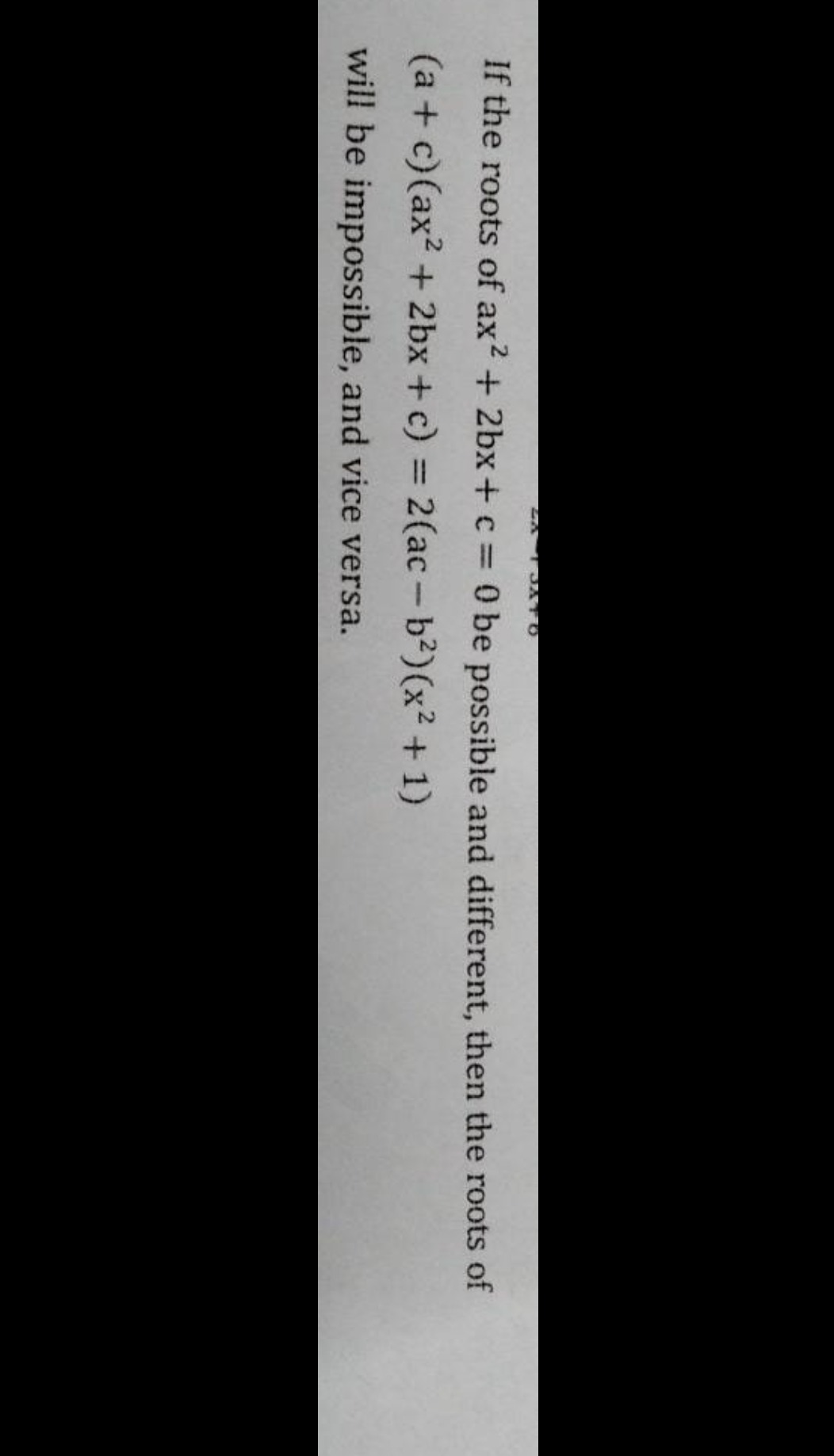Question
Question: If the roots of $ax^2 + 2bx + c = 0$ be possible and different, then the roots of $(a + c)(ax^2 + 2...
If the roots of ax2+2bx+c=0 be possible and different, then the roots of
(a+c)(ax2+2bx+c)=2(ac−b2)(x2+1) will be impossible, and vice versa.

The statement is proven
Solution
Let the first quadratic equation be P(x)=ax2+2bx+c=0. The roots of this equation are possible and different if its discriminant is positive. The discriminant is D1=(2b)2−4ac=4b2−4ac=4(b2−ac).
The condition for possible and different roots is D1>0, which means 4(b2−ac)>0, or b2−ac>0.
Let the second equation be (a+c)(ax2+2bx+c)=2(ac−b2)(x2+1).
We can rearrange this equation into the standard quadratic form Ax2+Bx+C=0.
Expanding the equation:
(a+c)ax2+(a+c)2bx+(a+c)c=2(ac−b2)x2+2(ac−b2)
a(a+c)x2+2b(a+c)x+c(a+c)=2(ac−b2)x2+2(ac−b2)
Moving all terms to the left side:
[a(a+c)−2(ac−b2)]x2+[2b(a+c)]x+[c(a+c)−2(ac−b2)]=0
[a2+ac−2ac+2b2]x2+2b(a+c)x+[ac+c2−2ac+2b2]=0
[a2−ac+2b2]x2+[2b(a+c)]x+[c2−ac+2b2]=0
Let the coefficients of the second equation be A=a2−ac+2b2, B=2b(a+c), and C=c2−ac+2b2.
The roots of the second equation are impossible (non-real) if its discriminant D2=B2−4AC is negative.
Let's calculate D2:
D2=[2b(a+c)]2−4(a2−ac+2b2)(c2−ac+2b2)
D2=4b2(a+c)2−4(a2−ac+2b2)(c2−ac+2b2)
Let k=b2−ac. Then b2=ac+k. The condition for the first equation's roots to be possible and different is k>0.
Substitute b2=ac+k into the expression for D2:
A=a2−ac+2(ac+k)=a2+ac+2k
C=c2−ac+2(ac+k)=c2+ac+2k
B=2b(a+c)
D2=4(ac+k)(a+c)2−4(a2+ac+2k)(c2+ac+2k)
D2=4(ac+k)(a2+2ac+c2)−4(a2c2+a3c+2a2k+ac3+a2c2+2ack+2kc2+2akc+4k2)
D2=4(a3c+2a2c2+ac3+a2k+2ack+c2k)−4(2a2c2+a3c+ac3+2a2k+4ack+2kc2+4k2)
D2=4[a3c+2a2c2+ac3+a2k+2ack+c2k−(2a2c2+a3c+ac3+2a2k+4ack+2kc2+4k2)]
D2=4[a3c−a3c+2a2c2−2a2c2+ac3−ac3+a2k−2a2k+2ack−4ack+c2k−2kc2−4k2]
D2=4[−a2k−2ack−c2k−4k2]
D2=4[−k(a2+2ac+c2)−4k2]
D2=4[−k(a+c)2−4k2]
D2=−4k[(a+c)2+4k]
Part 1: If the roots of ax2+2bx+c=0 are possible and different, then b2−ac>0.
Let k=b2−ac. So k>0.
The discriminant of the second equation is D2=−4k[(a+c)2+4k].
Since k>0, we have 4k>0.
Also, (a+c)2≥0 for real a and c.
Therefore, (a+c)2+4k>0.
Since k>0 and (a+c)2+4k>0, their product k[(a+c)2+4k] is positive.
Thus, D2=−4×(positive number)=negative number.
D2<0.
If the discriminant of the second equation is negative, its roots are impossible (non-real).
So, if the roots of the first equation are possible and different, the roots of the second equation are impossible.
Part 2: Vice versa. If the roots of the second equation are impossible, then the roots of the first equation are possible and different.
The roots of the second equation are impossible means D2<0.
D2=−4k[(a+c)2+4k]<0, where k=b2−ac.
Dividing by −4 and reversing the inequality sign, we get:
k[(a+c)2+4k]>0.
Let's consider the possibilities for k=b2−ac:
Case A: k=0.
If k=0, then 0×[(a+c)2+4(0)]=0.
The inequality k[(a+c)2+4k]>0 becomes 0>0, which is false.
So, k cannot be 0 if D2<0.
Case B: k<0.
If k<0, then for the product k[(a+c)2+4k] to be positive, the term [(a+c)2+4k] must be negative.
(a+c)2+4k<0
(a+c)2<−4k.
Since k<0, −4k>0. This inequality (a+c)2<−4k is possible (e.g., if a=1,c=1, then 4<−4k, so k<−1).
If k<0, the discriminant of the first equation D1=4k<0. This means the roots of the first equation are impossible (non-real).
However, the statement requires that if the roots of the second equation are impossible, then the roots of the first equation are possible and different (k>0).
So, the case k<0 is not consistent with the conclusion we want to reach (k>0).
Case C: k>0.
If k>0, then 4k>0.
(a+c)2≥0.
So, (a+c)2+4k>0+0=0.
Thus, k[(a+c)2+4k] is the product of two positive numbers (k>0 and (a+c)2+4k>0), which is positive.
k[(a+c)2+4k]>0.
This is consistent with the condition D2<0.
So, if the roots of the second equation are impossible (D2<0), then it must be that k=b2−ac>0.
If b2−ac>0, the discriminant of the first equation D1=4(b2−ac)>0.
This means the roots of the first equation are possible and different.
Combining both parts, we have shown that the roots of ax2+2bx+c=0 are possible and different if and only if the roots of (a+c)(ax2+2bx+c)=2(ac−b2)(x2+1) are impossible. This proves the given statement.
